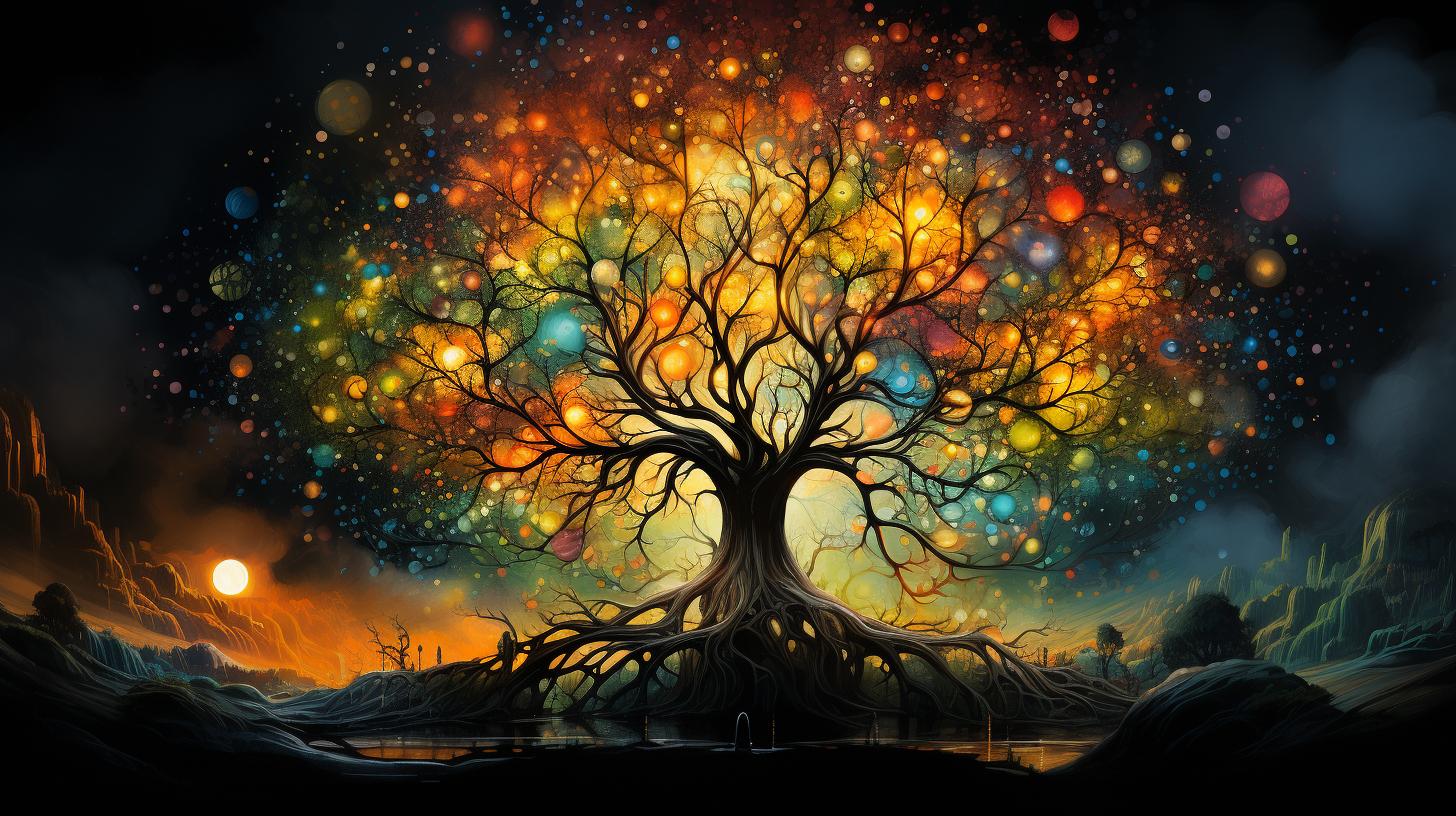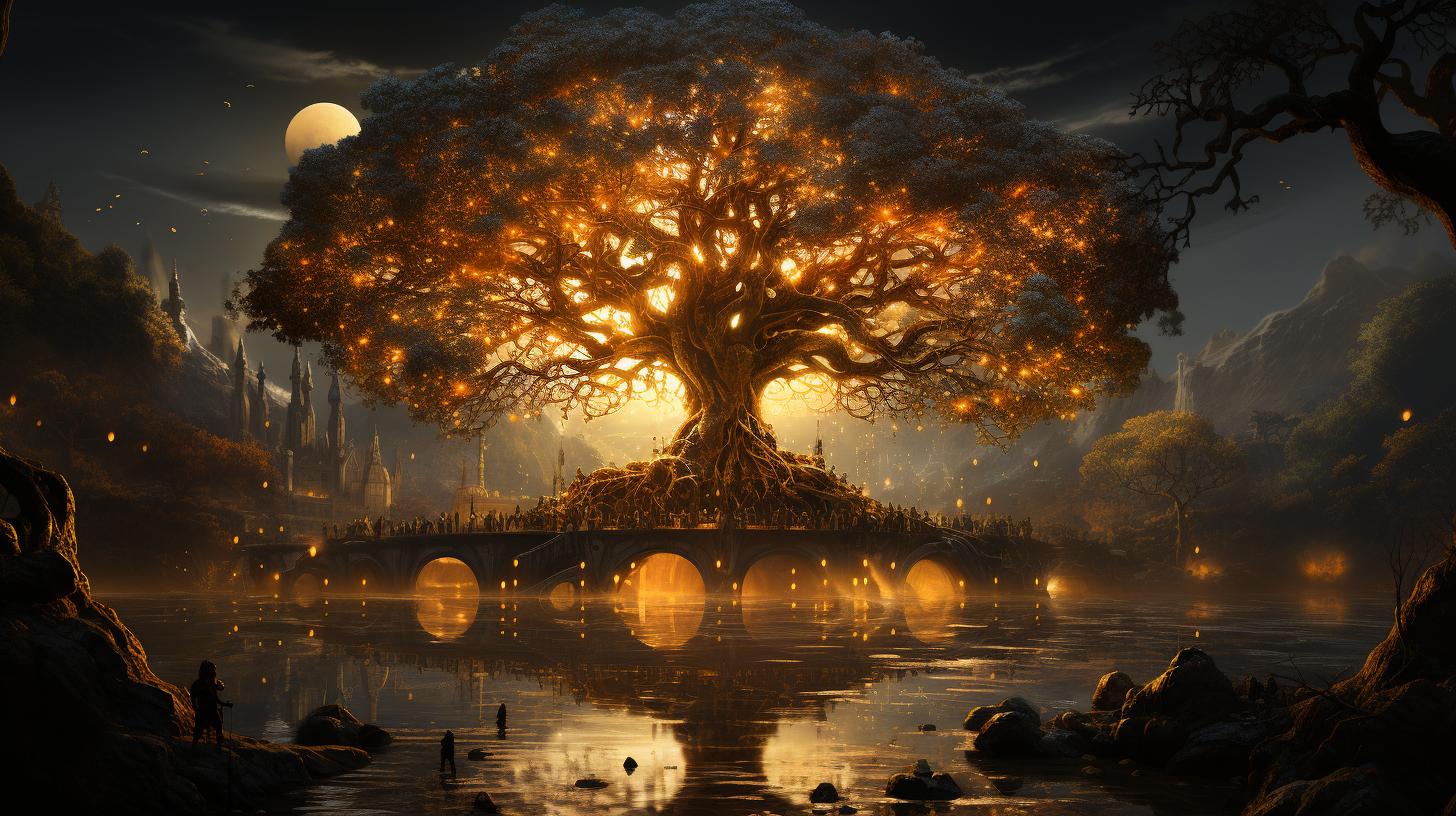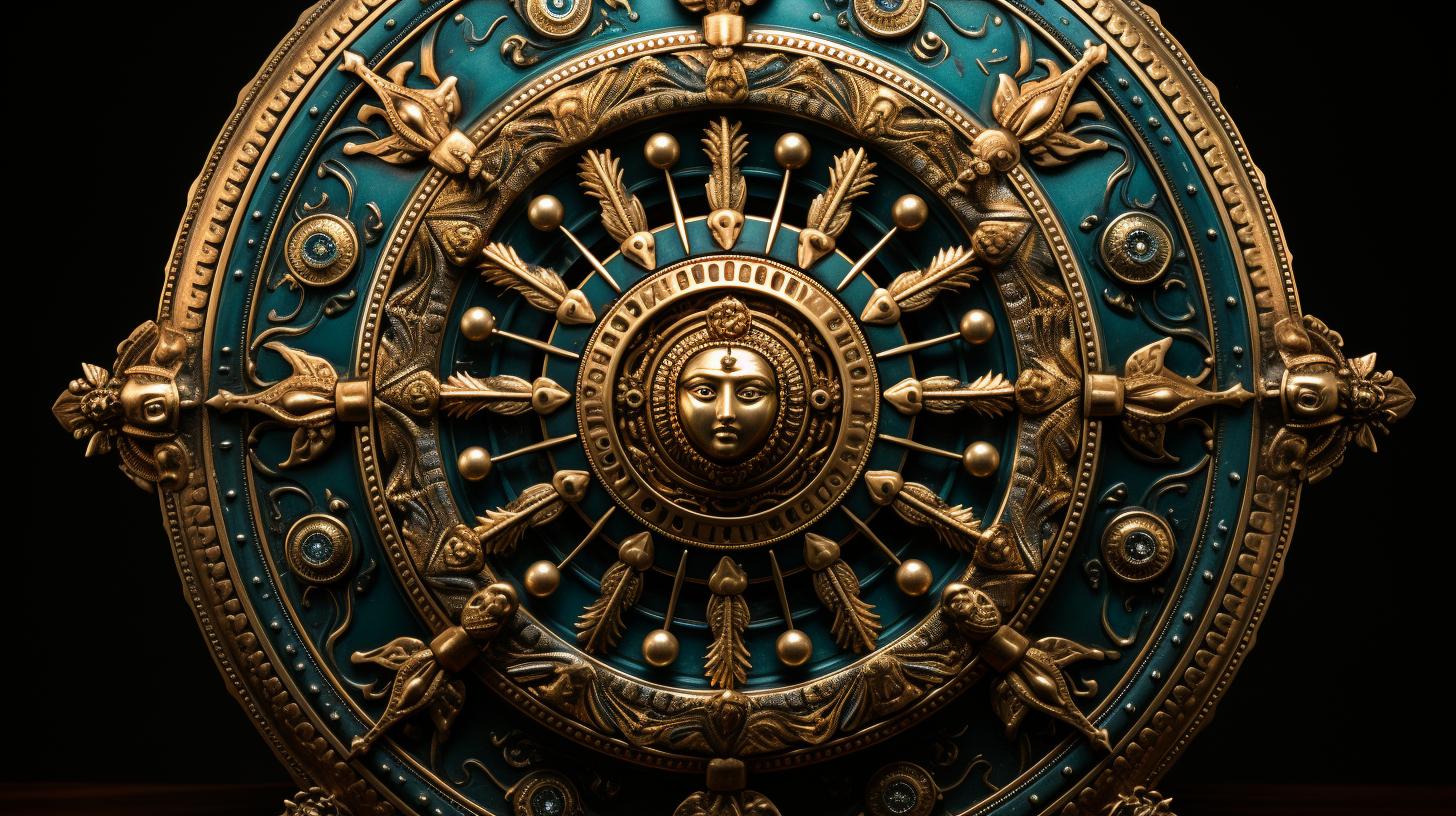Kalpavriksha Tree: A Sacred Symbol in Hinduism and Beyond

The Kalpavriksha tree holds great significance in Hinduism, Jainism, Buddhism, and Sikhism. According to Hindu beliefs, it emerged during the “Churning of the Milk Ocean” by the divine king Indra. In Jainism, there are ten Kalpavrikshas that fulfill wishes in different stages of the world cycle.
Buddhism represents the small Kalpavriksha tree atop a longevity vase in annual rituals. In Sikhism, it is referred to as “Parjat” or the “Tree of Paradise.” Various trees like banyan, coconut, ashwatha, and shami are identified as Kalpavriksha due to their ability to fulfill human needs.
Significance of Kalpavriksha in Hinduism
The Kalpavriksha holds immense significance in Hinduism, embodying the concept of wish-fulfilling trees. This sacred tree is deeply rooted in Hindu mythology, where it is believed to have emerged during the cosmic event known as the ‘Churning of the Milk Ocean’.
According to the legend, the gods and demons churned the Ocean of Milk in search of elixir, and during this process, the Kalpavriksha tree emerged as one of the treasures.
The Legend of Kalpavriksha in Hindu Mythology
In Hindu mythology, the Kalpavriksha is associated with the story of the gods’ quest for immortality.
It is said that Lord Indra, the king of gods, brought the divine tree to his paradise in the Milky Way after it emerged from the churning. The Kalpavriksha is believed to grant wishes, providing abundance, prosperity, and fulfillment.
Worship and Rituals Associated with Kalpavriksha
The Kalpavriksha tree holds great reverence among Hindus, and its worship and rituals are integral to Hindu culture. Devotees offer prayers, perform rituals, and tie threads around the tree seeking blessings and fulfillment of their desires.
It is also a common practice to circumambulate around the Kalpavriksha tree to seek its divine blessings.
- Devotees perform special ceremonies and ‘puja’ (worship) rituals under the shade of the Kalpavriksha.
- The leaves and flowers of the tree are considered sacred and are used in religious ceremonies and as offerings to deities.
- During festivals and important religious events, devotees gather around the Kalpavriksha to engage in communal prayers and seek spiritual blessings.
- The Kalpavriksha is also associated with environmental conservation and is often planted in temples and sacred groves to protect the ecosystem.
Thus, the Kalpavriksha tree epitomizes the fulfillment of desires, abundance, and spiritual blessings in Hinduism.
Its legend and worship continue to be an integral part of the religious and cultural heritage of Hindu followers.
Kalpavriksha in Jain Cosmology
In Jainism, the Kalpavriksha holds a significant place in the cosmological beliefs. According to Jain scriptures, there are ten Kalpavrikshas, also known as wish-fulfilling trees, which exist in the initial stages of each world cycle.
These sacred trees are believed to possess immense spiritual and symbolic power.
The Ten Kalpavrikshas in Jainism
The ten Kalpavrikshas in Jain cosmology are associated with different stages of the world’s existence. These trees are believed to fulfill various desires and offer blessings. Each tree is associated with a specific quality or blessing that it bestows upon those who seek it.
The ten Kalpavrikshas are:
- Ratnakaranda shravakachara: The tree that fulfills material desires
- Chakreshvari: The tree that grants energy and vitality
- Manoveg: The tree that enhances mental faculties
- Samyagdarshan: The tree that enlightens the mind and grants right vision
- Dhritivigyan: The tree that imparts stability and patience
- Arya Dravyasamgraha: The tree that provides knowledge of the noble substances
- Mahavira Vachan: The tree that conveys the teachings of Lord Mahavira
- Viryasamgraha: The tree that enhances strength and courage
- Pitchaichara: The tree that grants beauty and attractiveness
- Jiv daya: The tree that symbolizes compassion towards all living beings
Symbolism and Importance of Kalpavriksha in Jainism
The Kalpavriksha holds deep symbolism in Jainism.
It represents the ideal state of existence, where desires are fulfilled, and virtues are practiced. Just as the tree grants wishes, Jain followers aspire to cultivate qualities such as compassion, knowledge, and right vision represented by the ten Kalpavrikshas.
The presence of the Kalpavriksha in Jain cosmology reinforces the significance of leading a righteous and virtuous life.
Kalpavriksha in Buddhism
Buddhism holds its own unique perspective on the Kalpavriksha tree, incorporating it into their art, iconography, rituals, and ceremonies. The tree, often depicted as a small Kalpavriksha atop a long-life vase, carries deep symbolic meanings in Buddhist traditions.
Depictions of Kalpavriksha in Buddhist Art and Iconography
In Buddhist art and iconography, the Kalpavriksha tree is commonly represented as a sacred and wish-fulfilling tree. It is often depicted with lush foliage, vibrant flowers, and various mythical creatures surrounding it.
These depictions aim to convey the idea that the tree possesses divine qualities and is capable of granting the wishes of those who approach it with reverence and devotion.
Kalpavriksha in Buddhist Rituals and Ceremonies
The Kalpavriksha tree plays a significant role in Buddhist rituals and ceremonies. It is used as a focal point for offerings and prayers, symbolizing abundance, prosperity, and spiritual enlightenment. The tree represents the embodiment of spiritual awakening and is believed to bring good fortune and positive energy to those who engage in rituals and ceremonies centered around it.
Buddhists participate in annual rituals where they pay homage to the Kalpavriksha tree. These rituals involve offering flowers, incense, and other symbolic items to the tree, expressing gratitude and seeking blessings for health, longevity, and overall well-being.
The tree serves as a powerful reminder of the impermanence of life and the potential for spiritual growth and transformation.
In conclusion, the Kalpavriksha tree holds special significance within the realm of Buddhism. Its depictions in art and iconography highlight its role as a sacred and wish-fulfilling tree, while its presence in rituals and ceremonies provides an opportunity for spiritual connection and blessings.
Through its symbolism, the Kalpavriksha tree serves as an emblem of abundance, enlightenment, and the potential for personal and collective growth in Buddhist traditions.
Kalpavriksha Tree in Indian Culture and Society
Indian culture and society have a deep reverence for the Kalpavriksha tree, which is considered sacred and holds great significance.
Within Indian culture, several trees are identified as Kalpavriksha due to their ability to fulfill human needs and desires.
Sacred Trees in India: Banyan, Coconut, and Ashwatha
- The Banyan tree, with its extensive aerial roots and sprawling canopy, is often associated with the Kalpavriksha due to its symbol of longevity and immortality. It is believed to grant blessings and fulfill wishes.
- The Coconut tree, abundant in coastal regions, is another sacred tree associated with the Kalpavriksha.
It is revered for its versatility and is considered a symbol of abundance, prosperity, and purity.
- The Ashwatha tree, also known as the sacred fig or peepal tree, occupies a significant place in Indian culture.
It is believed to be an embodiment of Lord Vishnu and is associated with wisdom, growth, and spiritual enlightenment.
Kalpavriksha as a Symbol of Fulfilling Wishes
The Kalpavriksha tree holds the symbolism of wish fulfillment in Indian culture. It is believed that the tree has the power to grant wishes and bring prosperity and happiness to those who seek its blessings.
Many people visit these sacred trees, offer prayers, tie colorful threads, or leave offerings as a token of their devotion and to make their desires known.
The act of seeking blessings from the Kalpavriksha is deeply rooted in the belief that one’s wishes and desires can be fulfilled through the divine power residing within these trees.
It serves as a source of hope and inspiration for individuals, who hold strong faith in the mystical powers associated with the tree.
Conservation and Preservation of Kalpavriksha
Conservation and preservation efforts play a vital role in protecting the sacred Kalpavriksha trees and ensuring their survival for future generations. Various initiatives focus on safeguarding these trees, recognizing their cultural and ecological significance.
Sacred Groves and the Protection of Kalpavriksha
One crucial approach to the conservation of Kalpavriksha is the establishment of sacred groves. These groves are designated areas that serve as natural sanctuaries for these revered trees. They are protected by local communities and religious groups, who consider them sacred and believe in their divine association.
Sacred groves act as vital conservation spaces, promoting the growth and sustenance of Kalpavriksha.
Sacred groves not only provide habitat for the Kalpavriksha but also support a rich diversity of flora and fauna.
They create micro-ecosystems that contribute to the overall ecological balance and serve as gene banks for rare and endangered species. These groves also help in maintaining the water table, mitigating climate change impacts, and preserving soil fertility.
Efforts to Preserve the Endangered Kalpavriksha Trees
The endangered status of certain species of Kalpavriksha has sparked significant conservation initiatives. Organizations, researchers, and local communities are actively involved in efforts to protect and preserve these endangered trees.
Conservation programs focus on a variety of strategies, including habitat restoration, establishment of protected areas, and raising awareness about the importance of Kalpavriksha in local cultures and ecosystems.
These initiatives aim to address threats such as deforestation, urbanization, habitat fragmentation, and unsustainable extraction.
Collaborative efforts with government bodies, non-profit organizations, and local communities are essential for the success of conservation projects.
These partnerships enable the implementation of sustainable practices, monitoring of tree populations, and the development of conservation regulations and policies to prevent further degradation and loss of Kalpavriksha trees.
- Restoration of degraded habitats
- Establishment of protected areas
- Community involvement and education
- Promotion of sustainable practices
- Creation of awareness campaigns
To ensure the long-term survival of Kalpavriksha, continuous research, monitoring, and conservation efforts are paramount.
Protecting these sacred trees is not just an ecological obligation but also a cultural responsibility to preserve the spiritual and traditional values associated with Kalpavriksha in Indian society.
.




















